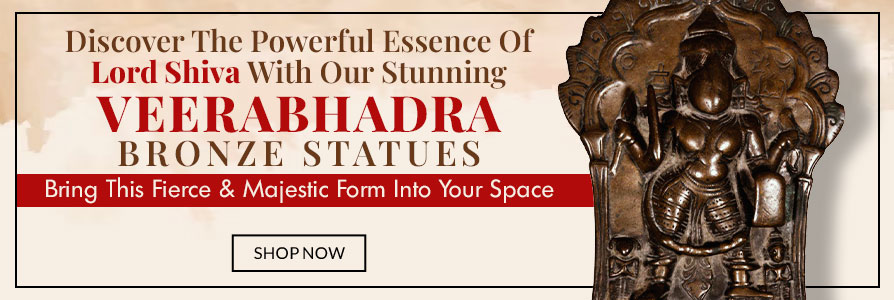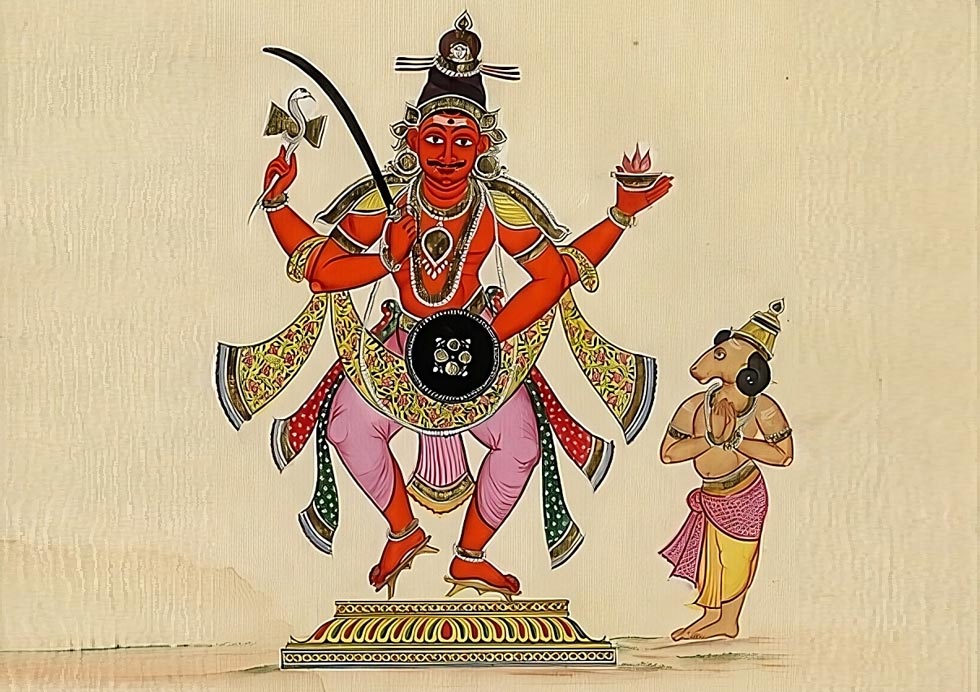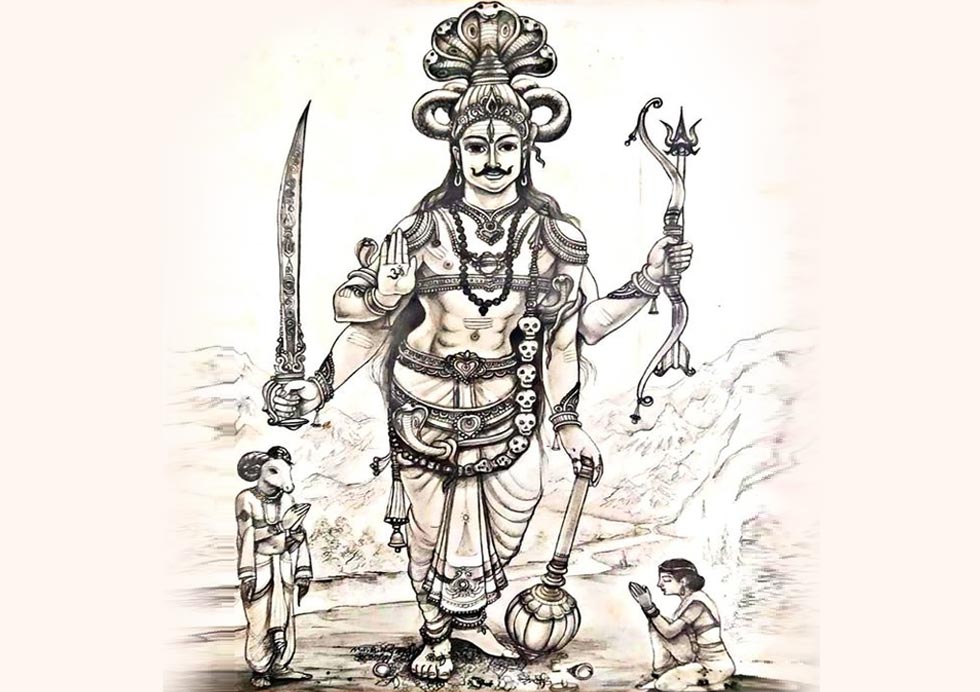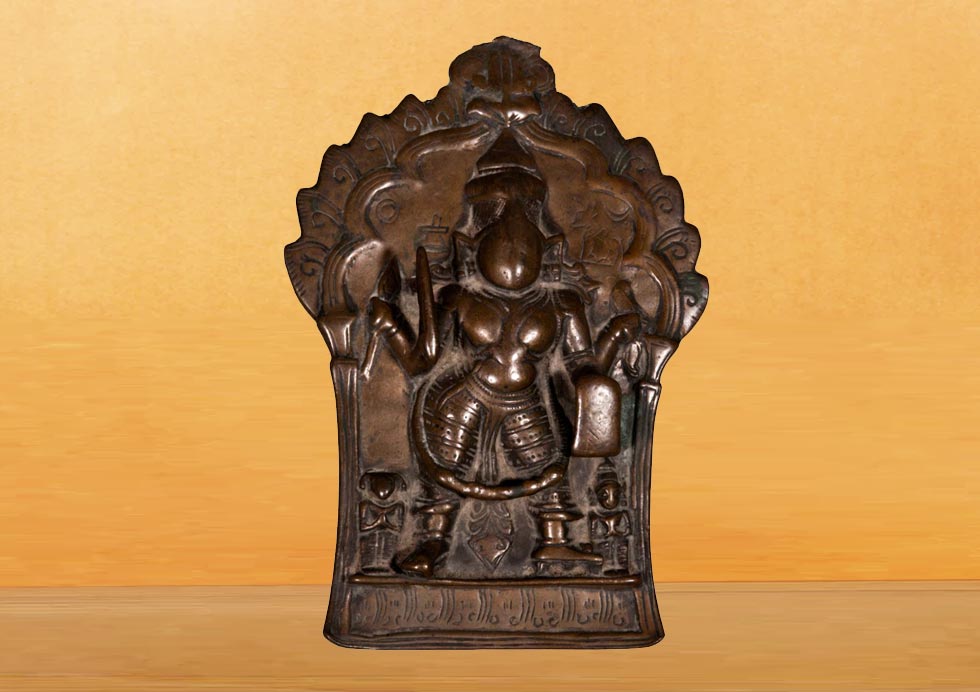
Veerabhadra, an embodiment of Shiva’s ferocious aspect, stands as a formidable figure within Hindu mythology. As part of Shiva’s retinue, known as the Shiva Pariwar, Veerabhadra joins the ranks of other deities like Nandi, Bhringi, and Chandesvara. His tale is one of symbolism, particularly highlighting the shedding of ego, as he was created by Shiva to play a crucial role in the cosmic conflict with Daksha.
In the intricate tapestry of Hindu narratives, Veerabhadra’s origin can be traced to the tumultuous events surrounding Daksha’s yajna (sacrifice) and the subsequent clash with Shiva. This warrior god also holds a prominent position as the principal deity in the Virasaiva movement, garnering reverence, especially in the Karnataka region of India. Dedicated temples further attest to Veerabhadra’s significance, with notable ones in Perambalur (Tamil Nadu), Lepakshi (Anantapur), and another in the town of Veerabhadra near Rishikesh.
In the intricate tapestry of Hindu narratives, Veerabhadra’s origin can be traced to the tumultuous events surrounding Daksha’s yajna (sacrifice) and the subsequent clash with Shiva. This warrior god also holds a prominent position as the principal deity in the Virasaiva movement, garnering reverence, especially in the Karnataka region of India. Dedicated temples further attest to Veerabhadra’s significance, with notable ones in Perambalur (Tamil Nadu), Lepakshi (Anantapur), and another in the town of Veerabhadra near Rishikesh.

Depiction of Veerabhadra Swamy
The artistic representations of Veerabhadra vividly capture the wrath and fierceness of Shiva. In his destructive form, Veerabhadra adorns a garland of skulls and wields four arms, each holding a distinct weapon. As a warrior god, Veerabhadra was historically worshiped during times of war in ancient and medieval periods.
Daksha Yagna and the Birth of Veerabhadra

The narrative unfolds with Daksha, displeased with Shiva, organizing a grand yajna to which Sati, Shiva’s consort, and Shiva himself were not invited. Despite Shiva’s warnings, Sati insisted on attending, leading to a tragic sequence of events. Sati immolates herself in the sacrificial fire, invoking Shiva’s intense grief and rage.
In his sorrow and fury, Shiva manifests Veerabhadra, a fierce warrior with a thousand arms and a formidable appearance. Directed by Shiva, Veerabhadra is tasked with disrupting Daksha’s yajna and avenging the disrespect shown towards Shiva.
In his sorrow and fury, Shiva manifests Veerabhadra, a fierce warrior with a thousand arms and a formidable appearance. Directed by Shiva, Veerabhadra is tasked with disrupting Daksha’s yajna and avenging the disrespect shown towards Shiva.
Veerabhadra and Bhadrakali

Accompanied by the wrathful goddess Bhadrakali, created by Mother Devi’s anger, Veerabhadra executes Shiva’s command. His mission is to spoil Daksha’s sacrifice, a symbolic act representing the destruction of ego and pride.
The intense confrontation unfolds with Veerabhadra scattering the gods, cutting off Daksha’s head, and dismantling the yajna. Vishnu plays a crucial role in intervening and seeking Shiva’s mercy, leading to the restoration of Daksha’s head with a goat’s head. Daksha, humbled, becomes a devoted follower of Shiva.
The intense confrontation unfolds with Veerabhadra scattering the gods, cutting off Daksha’s head, and dismantling the yajna. Vishnu plays a crucial role in intervening and seeking Shiva’s mercy, leading to the restoration of Daksha’s head with a goat’s head. Daksha, humbled, becomes a devoted follower of Shiva.
Symbolism of Veerabhadra Swamy
Beyond the mythological narrative, Veerabhadra carries profound symbolism. As Shiva’s manifestation of wrath, he represents the inherent power within individuals to overcome the prideful ego, depicted by Daksha. In this cosmic drama, Shiva embodies the Higher Self, Sati symbolizes the heart, and Daksha personifies the ego. The story unfolds as the Higher Self annihilates the ego for the sake of the heart, portraying a deeper spiritual lesson of compassion, forgiveness, and the pursuit of inner harmony.
In essence, Veerabhadra symbolizes the transformative power within, urging individuals to transcend ego-driven tendencies and embrace the path of spiritual evolution. The tale of Veerabhadra remains a timeless reminder of the eternal dance between destruction and creation within the cosmic order.
In essence, Veerabhadra symbolizes the transformative power within, urging individuals to transcend ego-driven tendencies and embrace the path of spiritual evolution. The tale of Veerabhadra remains a timeless reminder of the eternal dance between destruction and creation within the cosmic order.
Cultural Reverence and Worship
Veerabhadra holds a significant place in Hindu mythology and is particularly revered in the Virasaiva movement. Devotees, especially in the Karnataka region of India, continue to worship Veerabhadra as a powerful and protective deity. The temples dedicated to Veerabhadra, such as the ones in Perambalur, Tamil Nadu, Lepakshi in Anantapur, and the town of Veerabhadra near Rishikesh, serve as pilgrimage sites where the divine energy of Veerabhadra is venerated.
Iconography Of Veerbhadra

In his iconic portrayal, Veerabhadra’s stance is dynamic and forceful, capturing the essence of his swift and relentless nature. His multiple arms are arranged symmetrically, showcasing a harmonious balance in his divine form. The weaponry he brandishes symbolizes the cosmic arsenal at his disposal, reflecting his role as the divine enforcer of justice and cosmic order.
The choice of weapons in Veerabhadra’s hands holds significance. The sword represents discernment and the cutting of ignorance, while the trident symbolizes the trinity and his authority over the three gunas—Sattva, Rajas, and Tamas. The bow and arrows denote precision and focused energy, highlighting Veerabhadra’s ability to target and eliminate obstacles with precision. These symbolic weapons collectively underscore his role as a cosmic warrior, embodying the divine will to maintain equilibrium.
Veerabhadra’s crown of skulls is a powerful visual element, representing the transcendence of the cycle of birth and death. The skulls signify the ephemeral nature of mortal existence, emphasizing the eternal and immortal aspect of the divine. This imagery reinforces the overarching theme of cosmic balance and the inevitability of cosmic forces that surpass the limitations of worldly existence.
The dark complexion of Veerabhadra symbolizes the intensity of his divine rage and determination, while his eyes radiate a fiery glow, signifying the divine energy and awareness that fuel his actions. The overall iconography of Veerabhadra serves as a visual narrative, conveying the cosmic narrative of righteousness prevailing over egoistic forces through the relentless and formidable manifestation of Shiva’s wrath in the form of Veerabhadra.
The choice of weapons in Veerabhadra’s hands holds significance. The sword represents discernment and the cutting of ignorance, while the trident symbolizes the trinity and his authority over the three gunas—Sattva, Rajas, and Tamas. The bow and arrows denote precision and focused energy, highlighting Veerabhadra’s ability to target and eliminate obstacles with precision. These symbolic weapons collectively underscore his role as a cosmic warrior, embodying the divine will to maintain equilibrium.
Veerabhadra’s crown of skulls is a powerful visual element, representing the transcendence of the cycle of birth and death. The skulls signify the ephemeral nature of mortal existence, emphasizing the eternal and immortal aspect of the divine. This imagery reinforces the overarching theme of cosmic balance and the inevitability of cosmic forces that surpass the limitations of worldly existence.
The dark complexion of Veerabhadra symbolizes the intensity of his divine rage and determination, while his eyes radiate a fiery glow, signifying the divine energy and awareness that fuel his actions. The overall iconography of Veerabhadra serves as a visual narrative, conveying the cosmic narrative of righteousness prevailing over egoistic forces through the relentless and formidable manifestation of Shiva’s wrath in the form of Veerabhadra.
Conclusion
In essence, the tale of Veerabhadra transcends the boundaries of myth and legend, offering profound insights into the human experience. The cosmic drama of Daksha’s Yagna serves as a mirror reflecting the eternal struggle within individuals to overcome ego, embrace humility, and reconnect with the divine. Veerabhadra, with his imposing presence and divine purpose, remains a potent symbol of the transformative power that lies within the pursuit of higher consciousness.
As worshippers continue to revere Veerabhadra and reflect on his symbolic significance, the ancient narrative continues to resonate, imparting timeless lessons of spiritual evolution and the eternal dance between the forces of creation and destruction within the vast cosmic tapestry of Hindu mythology.
As worshippers continue to revere Veerabhadra and reflect on his symbolic significance, the ancient narrative continues to resonate, imparting timeless lessons of spiritual evolution and the eternal dance between the forces of creation and destruction within the vast cosmic tapestry of Hindu mythology.









